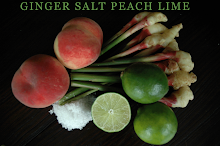It's early February, and I find that I'm the perplexed owner of eight bottles of champagne. There they are, lying along the bottom shelf of the fridge on their tummies, stretched out, practically yawning. It all came about after over-estimating our needs on New Year's. I thought each person would have about three glasses of champagne. I should have counted more carefully and bought more Knob Creek. Oh, those lessons learned.
Is there something you can make with so much leftover champagne? A lifetime supply of vinegar? Soup? And who in her right mind has leftover champagne?
Thus, breakfast. And, as this is Saturday, a tiny little hangover. So, I decided to treat a couple of friends to my version of Japanese breakfast. I'm sure there's no such thing as Japanese breakfast, much like there's no such thing as Chinese take out in China. Here, breakfast is just breakfast, and it's quickly becoming my favorite feast at the beginning of the day. As best I can tell, the meal usually includes miso soup, broiled fish, eggs (typically made as a beautiful, rolled omelet), steamed rice and pickles. And hiyayakko, cold tofu.
Hiyahakko is a simple dish of drained tofu topped with grated ginger, bonito flakes, chopped leek or green onion, and soy sauce with dashi (fish broth). It takes less time to assemble than it does to type this sentence, so I eat it about two or three times a week. But this morning, I decided to include the tofu in hot miso soup. My apartment is pretty chilly, as was my hangover. Thus, soup.
So I broiled the fish after dousing it with mirin, sesame oil and soy sauce. The rice steamed, the eggs -- scrambled with a little more sesame -- slowly cooked in the skillet. And the miso soup made the whole place smell earthy and good.
"How do you make miso soup?" my friend asked.
I paused. My Japanese friends may shudder slightly, but I've come up with my own version which is limited by my ability to read konji but enhanced by my love of mushrooms. But I think it's alright. Miso soup is one of those things that is based on a spoonful of ground soy beans. It's a little like asking how one makes cinnamon-sugar. You mix the ingredients until you're happy with what's in the bowl.
So I showed her my version. And then, we served it all up. A few massive cinnamon rolls from a nearby bakery, hot tea and good orange juice. And, then the pop. Hooray.
We tucked in just before noon and sipped and snacked. We talked about all the things girls talk about during a lazy breakfast with mimosas -- boys, car accidents, global politics, the best way into Tibet, boys. We made more tea, finally put away the leftovers around 3, and moved to the couch. It was another hour before we decided to fully wake up and start the day. More than Japanese breakfast, I love a meal that lasts all day.
My miso soup
When I asked one of my Japanese friends which kind of miso paste I should buy, she shrugged her shoulders. "The one on sale," she said, standing before the refrigerated shelve holding at least a dozen different brands and styles. Miso paste ranges from almost almond-colored (white) to a dark, rich peanut butter version. For now, I've settled on the paste that has a bit of a tan, and, usually, is on sale. It comes in a tub or plastic bag, and it lasts in the fridge for months. Theoretically, that is.
Broth
Miso soup starts with water infused with bonito flakes and kombu. I keep forgetting to buy kombu, so mine starts with water and bonito (flaked, dried fish). I put one package of bonito (about a handful of fish flakes) into about four cups of water. Bring just to a boil and turn off. Strain the bonito, reserving the broth. Return broth to the pan and put on a slow burner.
To the broth, I add one soup spoon of miso paste and mix until dissolved. Taste it and see if it's salty enough or strong enough for you. Add a little water if it's too strong; add a little more paste if it's too bland. Then, I usually add whatever mushrooms I have on hand. I just cut them in bite-sized pieces and add to the broth. (I would avoid button or portabello and stick to Asian versions.) They usually need about five to ten minutes in the broth.
Bowl
To the soup bowl, I add a tablespoon or two of thinly sliced leeks (negi, in Japan), and either chopped tofu or a package of fresh soba noodles. When ready to eat, ladle the mushrooms and miso into each bowl. The steamy broth will warm the noodles or tofu perfectly.
Four cups of water will make enough for one dinner or two to three smaller servings as side dishes for any meal. The miso and broth will separate in the fridge, but it will come together just fine when reheated.
Subscribe to:
Post Comments (Atom)


1 comment:
Hello - I just recently ran across your blog.
I typically make miso using hon-dashi (I've also heard it called just dashi) rather than bonito. I assume the taste probably comes out about the same, but the dashi dissolves into the broth so that you don't have to strain it out. It's a little easier to come across in the US than the bonito also - at least where I am.
Post a Comment